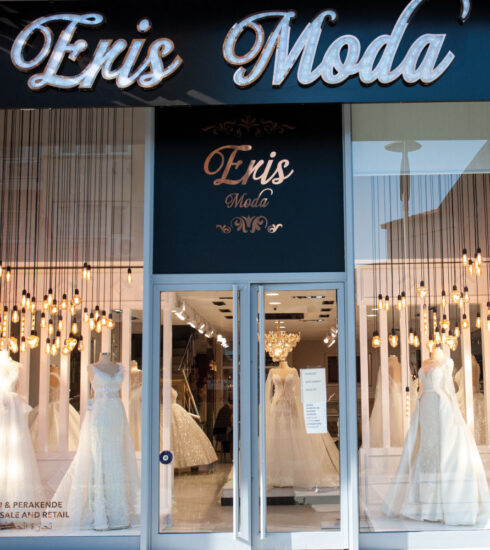Türklerde Gelinlik
Türklere göre, düğün Tanrı kutunun yeryüzüne inişi demektir.
Türk milleti, evlilik ile kurulan aile ocağının bakıcısı, koruyucusu olan geline kutsal bir anlam yükler. Eski Türkçede “kelin” olarak ifade edilen gelin kavramı, Türklerde ilk yaratılan kadını sembolize eder. Oğuz Destanı’nda gece, gökten ışıklar içinde bir gelin iner.
Tanrı katından ona armağan edilmiş olan özellikleri yeryüzüne indirir. Mitolojide Türk gelinleri, alnında kutup yıldızı gibi ışık olan, güzelliği dillere destan, namuslu, gözü pek, savaşçı kadınlardır.
Yani Türk inanışına göre gelin kutludur. Tanrı kutu onunla birlikte aileye iner. Böylesine özel anlamlar yüklenen gelinin kıyafeti de de kutsal semboller içerir. Örneğin gelinin kıyafeti ve duvağı Türk kültüründe kutsal olarak kabul edilen kırmızı renkten yapılır. Al ve kızıl renkler, Türk ruhu ve inancını yansıtmaktadır.


Al renk “Al ruhunun” sembolüdür. Sonsuzluk ve mutluluk anlamına gelir. O nedenle, düğün günü, aileye saadet getirmesi amacıyla geline kırmızı renkli giysi giydirirler.
Al renk “Al ruhunun” sembolüdür. Sonsuzluk ve mutluluk anlamına gelir. O nedenle, düğün günü, aileye saadet getirmesi amacıyla geline kırmızı renkli giysi giydirirler. Gelin, baba evinden başında al renkli duvakla çıkar. Bu duvak, kutlu gelini doğaüstü kötü güçlerin etkisinden korumak için örtülür. Başa örtülen al renkli duvak ve bele bağlanan al kuşak, gelinin tanrı katından yeryüzüne inişini, bekâreti, simgeler. Gelinin atası, kızın başına duvağı örterek onun velayet hakkını damada vermiş olur.
Duvağın üzerine ince, parlak teller konulur. Değerli taşlarla süslü hotoz (TDK ‘a göre; isim, Kadınların süs için saçlarının üstüne taktıkları, çeşitli renk ve biçimde yapılmış küçük başlık) giydirilir. Tanrı tarafından kuş şeklinde yeryüzüne indirilen kadını simgeleyen kuş işlemeler, gelin elbisesinin göğsüne işlenir. Bu gelenekler, günümüzde halen Orta Asya’nın bazı bölümlerinde olduğu gibi Anadolu’nun pek çok şehrinde de uygulanmaktadır.

Osmanlılar zamanında ise gelinlikler süslü ve işlemeli olarak hazırlanır, düğün sonrasında gündelik yaşamda giyilebilir biçimde dikilirdi. Gelinlikler, genç kızların ilk gösterişli giysisiydi. Evlenmeden önce kızların süslü giyinmesi toplum içinde hoş karşılanmadığından gelinlik genç kızlar için o güne kadar giydikleri en güzel giysi olurdu. Sadece evli kadınlar süslü giysiler giyebilirlerdi.
Osmanlılarda gelinlik modelleri hangi sosyal sınıftaysanız ona göre değişirdi. Yani saray hanedanları başka, kırsal kesimden olanlar başka biçimlerde gelinlikler giyerdi.
Halk arasında giyilen gelinlikler, kırmızı, mor, mavi, pembe gibi farklı renklerde olabiliyordu. Biçimleri, kullanılan kumaşlar, nakış şekilleri, işlemeler, Osmanlı içinde yaşayan halkların geleneklerine hatta yaşanılan bölgelere göre farklılık gösterirdi.
Tarihi 14-15. yüzyıla dek uzanan, kadife, saten, ipek ve atlas kumaştan dikilen bindallılar da, düğün kıyafetleri arasında yer almaktaydı. Bindallı işlemeciliği ağır el emeği isteyen bir işti. Kumaşları ise oldukça pahalıydı. O nedenle bindallı giymek statü göstergesiydi. Düğünlerde kırmızı, lacivert, pembe renklerde olanları tercih edilirdi.
Hanedan üyeleri düğünde kırmızı gelinlik giyerlerdi. Elbise iki taraftan yırtmaçlıydı. Kollar bilekten yaklaşık bir karış aşağıya sarkardı. Giysinin arka tarafı yerde sürünmesi için biraz uzun bırakılırdı. Taç takılacaksa, bu bir başlık eşliğinde başın üzerine konulurdu. Başlığa gelin teli olarak adlandırılan ince gümüş tel takılırdı. Pembe renkli bir tül tacın arka tarafına tutturulurdu. Kırmızı duvak gelinliği tamamlayan en önemli unsurdu.
16.yüzyıla kadar gelin başı olarak fes kullanılırdı. Bu başlıklar altın ve gümüş kullanılarak süslenirdi. Saçlar iki örgü halinde örülür, altın, gümüş, ya da sosyal durum uygunsa değerli taşlarla süslenir ve fes takılırdı. Süslemede örtüler de kullanılmaktaydı.
Taç, Abdülmecid zamanında gelin başlıklarını süslemeye başladı.
Günümüzde olduğu gibi o günlerde de gelinlik masrafları bir hayli fazlaydı. Bütçesi yeterli olmayan aileler, bir iki günlüğüne kızlarına başlık kiralarlardı. Başlıklar, “Başlıkçı” adı verilen kimselerden kiralanırdı. Bunlar, büyükşehirlerde bulunurlardı.
Başlıkçılar, esnaf mensubu varlıklı, dul kadınlardan olurdu. Bu kişiler, düğün evine gelerek kalır ve başlık süsleme işini yaparlardı.
Tarihler 1870 yılını gösterdiğinde batının da etkisi ile gelinlik renkleri pastel olmaya başladı.
1898 yılında, Osmanlı sarayında yapılan bir düğün ile hanedan mensupları arasında gelinlik rengi olarak geleneksel kırmızı renk yerine beyaz tercih edilmeye başlandı.
2. Abdülhamid’in kızı Naim’e Sultan, Kemalettin Paşa ile evlenirken Avrupa’da Kraliçe Victoria’nın yıllar önce başlattığı modaya uyup gelinlik rengi olarak beyazı tercih edince, kırmızı gelinlik yerini bembeyaz gelinliklere bıraktı.
Gelinliğin biçimi pek tabii bugünün gelinliklerinden farklıydı. Kıyafet uzun ve dört etekliydi. İnci ve sırma ile işlenmişti. Etekler yere bırakılmış bir haldeydi. Göğüs kısmından aşağıya kadar pırlanta düğmeler yer alıyordu. Bel kısmında altın kemer vardı. Naime Sultan’ın gelinliğinde kırmızı yerine beyazı seçmesi geleneklere sıkı sıkıya bağlı kesimlerce tenkit edildi.
1912’de Hidiv Abbas Hilmi’nin kızı Atiye hanım, düğünü için beyaz saten bir gelinliği seçince eleştiri oklarının hedefi oldu.
O günlerde gelinliklerde beyaz renk tercih edlmeye başlansa da duvak rengi hala kırmızı olarak kullanılıyordu.
İlk kez Avrupai tarzda dikilmiş olan gelinliği, 2. Abdülhamid’in torunu olan Adile Sultan 1917 yılında giydi. Gelinliğin duvağı da beyaz renkteydi.
Tanzimat dönemi sonrasında batının etkisinin artması, sonrasında da cumhuriyet reformlarıyla gelen batılılaşma hareketleriyle birlikte Türklerin Orta Asya bozkırlarından beri süre gelen gelenekler doğrultusunda biçimlenmiş gelinlik tarzı yerini tüm dünyayı saran beyaz gelinlik modellerine bırakmış oldu.
O günden bu güne gelinlerimiz beyaz gelinlik ile dünya evine giriyor.
Which means brides are sacred according to Turkish beliefs. The god comes down to the family with her.
The dress of the bride that holds so much meaning also contains sacred symbols. For example, the clothing and veil are made from the color red which is thought to be sacred by Turks. Red and scarlet colors mirror the Turkish spirit and beliefs.
The color red is the symbol for the “Red spirit”. It means eternity and euphoria. That’s why, the bride is dressed in red on the wedding day to bring felicity to the family.
The bride leaves their family home with a red veil. This veil is believed to protect the sacred bride from the harm brought by supernatural, evil forces.


The color red is the symbol for the “Red spirit”. It means eternity and euphoria. That’s why, the bride is dressed in red on the wedding day to bring felicity to the family.
The veil that shrouds the bride, and the sash that is tied around the waist symbolizes the arrival of the bride from the heart of the God and virginity.
The progenitor of the bride honors the groom with the curatorship of her by shrouding her with the veil.
Fine and shiny chords are placed on top of the veil. A crest that is called “hotoz” is worn on top of the veil. This crest is decorated with precious stones. Birds are embroidered around the breast to symbolize the arrival of the bride to the world as a bird by the God.
These traditions are still carried out in some parts of Middle Asia and in many cities in Anatolia today.In the Ottomans, the ornate and embroidered bridals were prepared and sown to be able to be worn in the daily life after the wedding. The bridals were the first flashy clothing for young women as wearing fancy clothes before marrying was not welcomed among the society. Only married women were allowed to wear ornate clothes.
The bridal models changed depending on your social standing in the Ottomans. This meant that the nobles and the ordinary people wore different types of bridals.

The bridals that were worn by the commoners could be red, purple, blue, pink or other colors like these. The style, fabric, embroidery types changed depending on the traditions of multiple communities or even the geography.
Sown by velvet, sateen, silk and atlas fabrics; “bindallı” was also among the wedding dresses back until the 14th and 15th century. Bindallı embroidering required heavy handiwork and the fabrics were expensive. That is why wearing a bindallı proved a higher status. Red, dark blue and pink ones were preferred at weddings.
Noble family wore red at weddings. The dress had two slits at its side. Arms drooped by about a handspan. The rear of the dress would be left a little longer to drag on the ground. If a circlet were to be used, it would be worn with a cap. A thin silver cord would be fitted to the cap. The cord was named as the bridal cord. A pink tulle would be latched to the back of the circlet. The red veil was the most important aspect that completed the bridal.
The fez was used as a headwear for the bride. These headpieces would be decorated using gold and silver. The hair would be braided as two, garnished with gold, silver or precious stones if the social standing was appropriate and fez would be worn. Clothes were also used among the decorations.
The circled appeared around Abdulmecid’s time.
The bridals were costly as they are today. The families that could not afford them rented headpieces for their girls. These headpieces were rented by people called “Başlıkçı” (headpiece seller). These could be found in major cities.
These sellers were artisan widows that were greatly wealthy.
These women would stay at the wedding house and do the headpiece for the bride.
The bridal color palette shifted to be more pastelle at around 1870 by the western influence.
At 1898, with a wedding that was done at an Ottoman palace, the bridal color was preferred to be white instead of the traditional red by the noble family.
When the daughter of Abdülhamid the 2nd, Naim’e Sultan married with Kemalettin Pasha chose white as a bridal color following the fashion trend started by the Queen Victoria in Europe years ago, red bridals left their places for white ones.
The form of the bridal was of course different that today’s bridals. The dress was long and had 4 skirts. It was embroidered by pearls and passementerie.
The skirts were on the ground. Diamond buttons was present down from the breast region. There was a golden belt around the waist area. The fact that Naime Sultan preferred white instead of red was not welcomed by the conservatives.
The daughter of Hidiv Abbas Hilmi, Madam Atiye, became the target of heavy criticism when she chose a white sateen bridal for her marriage in 1912.
Even though the white was becoming the norm around those days, the veil was still red.
The first bridal that was sown with a European style was worn by Adile Sultan, the granddaughter of Abdülhamid the 2nd in 1917. The veil was also white.
The increase of western influence following the tanzimat reform era, and the westernization efforts by the republican reforms meant that the traditional bridal style that came from the Middle Eastern times left its place to white bridal designs that was the global phenomena at the time.
Since then, our brides enter into matrimony with white bridals.
Wedding is the arrival of God to the world for Turks.
Turkish people load a sacred meaning to the bride, who is the protector and the caretaker of the hearth and home that is started by the wedding.
The word that is written as “kelin” in old Turkish, symbolizes the first woman that walked the Earth. A bride walks down from the sky among lights in the Oghuz Saga. She brings down qualities that were gifted to her by God. Turkish brides in mythology have shimmers that rivals the north star on their foreheads and are beautiful beyond imagination and warriors with purity.
Which means brides are sacred according to Turkish beliefs. The god comes down to the family with her.
The dress of the bride that holds so much meaning also contains sacred symbols. For example, the clothing and veil are made from the color red which is thought to be sacred by Turks. Red and scarlet colors mirror the Turkish spirit and beliefs.
The color red is the symbol for the “Red spirit”. It means eternity and euphoria. That’s why, the bride is dressed in red on the wedding day to bring felicity to the family.
The bride leaves their family home with a red veil. This veil is believed to protect the sacred bride from the harm brought by supernatural, evil forces.


The color red is the symbol for the “Red spirit”. It means eternity and euphoria. That’s why, the bride is dressed in red on the wedding day to bring felicity to the family.
The veil that shrouds the bride, and the sash that is tied around the waist symbolizes the arrival of the bride from the heart of the God and virginity.
The progenitor of the bride honors the groom with the curatorship of her by shrouding her with the veil.
Fine and shiny chords are placed on top of the veil. A crest that is called “hotoz” is worn on top of the veil. This crest is decorated with precious stones. Birds are embroidered around the breast to symbolize the arrival of the bride to the world as a bird by the God.
These traditions are still carried out in some parts of Middle Asia and in many cities in Anatolia today.In the Ottomans, the ornate and embroidered bridals were prepared and sown to be able to be worn in the daily life after the wedding. The bridals were the first flashy clothing for young women as wearing fancy clothes before marrying was not welcomed among the society. Only married women were allowed to wear ornate clothes.
The bridal models changed depending on your social standing in the Ottomans. This meant that the nobles and the ordinary people wore different types of bridals.

The bridals that were worn by the commoners could be red, purple, blue, pink or other colors like these. The style, fabric, embroidery types changed depending on the traditions of multiple communities or even the geography.
Sown by velvet, sateen, silk and atlas fabrics; “bindallı” was also among the wedding dresses back until the 14th and 15th century. Bindallı embroidering required heavy handiwork and the fabrics were expensive. That is why wearing a bindallı proved a higher status. Red, dark blue and pink ones were preferred at weddings.
Noble family wore red at weddings. The dress had two slits at its side. Arms drooped by about a handspan. The rear of the dress would be left a little longer to drag on the ground. If a circlet were to be used, it would be worn with a cap. A thin silver cord would be fitted to the cap. The cord was named as the bridal cord. A pink tulle would be latched to the back of the circlet. The red veil was the most important aspect that completed the bridal.
The fez was used as a headwear for the bride. These headpieces would be decorated using gold and silver. The hair would be braided as two, garnished with gold, silver or precious stones if the social standing was appropriate and fez would be worn. Clothes were also used among the decorations.
The circled appeared around Abdulmecid’s time.
The bridals were costly as they are today. The families that could not afford them rented headpieces for their girls. These headpieces were rented by people called “Başlıkçı” (headpiece seller). These could be found in major cities.
These sellers were artisan widows that were greatly wealthy.
These women would stay at the wedding house and do the headpiece for the bride.
The bridal color palette shifted to be more pastelle at around 1870 by the western influence.
At 1898, with a wedding that was done at an Ottoman palace, the bridal color was preferred to be white instead of the traditional red by the noble family.
When the daughter of Abdülhamid the 2nd, Naim’e Sultan married with Kemalettin Pasha chose white as a bridal color following the fashion trend started by the Queen Victoria in Europe years ago, red bridals left their places for white ones.
The form of the bridal was of course different that today’s bridals. The dress was long and had 4 skirts. It was embroidered by pearls and passementerie.
The skirts were on the ground. Diamond buttons was present down from the breast region. There was a golden belt around the waist area. The fact that Naime Sultan preferred white instead of red was not welcomed by the conservatives.
The daughter of Hidiv Abbas Hilmi, Madam Atiye, became the target of heavy criticism when she chose a white sateen bridal for her marriage in 1912.
Even though the white was becoming the norm around those days, the veil was still red.
The first bridal that was sown with a European style was worn by Adile Sultan, the granddaughter of Abdülhamid the 2nd in 1917. The veil was also white.
The increase of western influence following the tanzimat reform era, and the westernization efforts by the republican reforms meant that the traditional bridal style that came from the Middle Eastern times left its place to white bridal designs that was the global phenomena at the time.
Since then, our brides enter into matrimony with white bridals.




